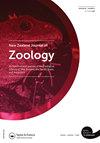在新西兰奥特罗阿,eDNA是一种很有前途的工具,用于补充淡水鱼类群落的河流评估
IF 1.1
4区 生物学
Q3 ZOOLOGY
引用次数: 8
摘要
摘要在新西兰奥特亚,人们对水道健康越来越感兴趣。《2020年淡水管理国家政策声明》(NPS-FM)赋予资源管理者更大的责任,报告淡水生态系统健康状况,包括鱼类。常规鱼类监测是时间密集型的,主要在“可涉水”河段进行。相比之下,环境DNA(eDNA)采样是一种相对较新且快速的技术,可能在更广泛的空间尺度上检测鱼类和其他脊椎动物和无脊椎动物分类群。在这项研究中,我们提供了五条可涉水溪流的数据,比较了多年标准化电铸产生的多样性与从同一河段收集的eDNA样本。此外,我们还探讨了一个地点物种的eDNA监测“读数”数量是否可以根据一次电抛光捕获提供其“近场”相对丰度的近似(半定量)指示。结果表明,虽然该方法的某些方面需要微调,但eDNA采样显示出很大的前景,可以补充环境状况(SOE)报告,以描述可涉水溪流中的鱼类多样性。还讨论了使用水生eDNA监测来提供可涉水和不可涉水溪流中更广泛的集水区规模生物多样性(如鸟类和外来害虫)的成本效益指标。本文章由计算机程序翻译,如有差异,请以英文原文为准。
Sucked in by eDNA – a promising tool for complementing riverine assessment of freshwater fish communities in Aotearoa New Zealand
ABSTRACT There is increasing interest in the health of waterways in Aotearoa New Zealand. The National Policy Statement for Freshwater Management 2020 (NPS-FM) places a greater onus on resource managers to report on the state of freshwater ecosystem health, including fish. Routine fish monitoring is time intensive and is principally conducted in ‘wadeable’ stream reaches. In comparison, environmental DNA (eDNA) sampling is a relatively recent and rapid technique that likely detects fish and other vertebrate and invertebrate taxa over a broader spatial scale. In this study, we present data for five wadeable streams comparing diversity derived from multi-year standardised electrofishing with eDNA samples collected from the same reaches. Further, we explore whether the number of eDNA monitoring ‘reads’ for species at a site may provide an approximate (semi-quantitative) indication of their ‘near field’ relative abundance based on one-pass electrofishing captures. Results indicated that while some aspects of the methodology require fine-tuning, eDNA sampling shows substantial promise for complimenting state of the environment (SOE) reporting for describing fish diversity in wadeable streams. The use of aquatic eDNA monitoring to provide a cost-effective indication of broader catchment scale biodiversity (e.g. birds and exotic pests) in wadeable and non-wadeable streams is also discussed.
求助全文
通过发布文献求助,成功后即可免费获取论文全文。
去求助
来源期刊
CiteScore
2.80
自引率
0.00%
发文量
20
审稿时长
>12 weeks
期刊介绍:
Aims: The diversity of the fauna of the southern continents and oceans is of worldwide interest to researchers in universities, museums, and other centres. The New Zealand Journal of Zoology plays an important role in disseminating information on field-based, experimental, and theoretical research on the zoology of the region.

 求助内容:
求助内容: 应助结果提醒方式:
应助结果提醒方式:


